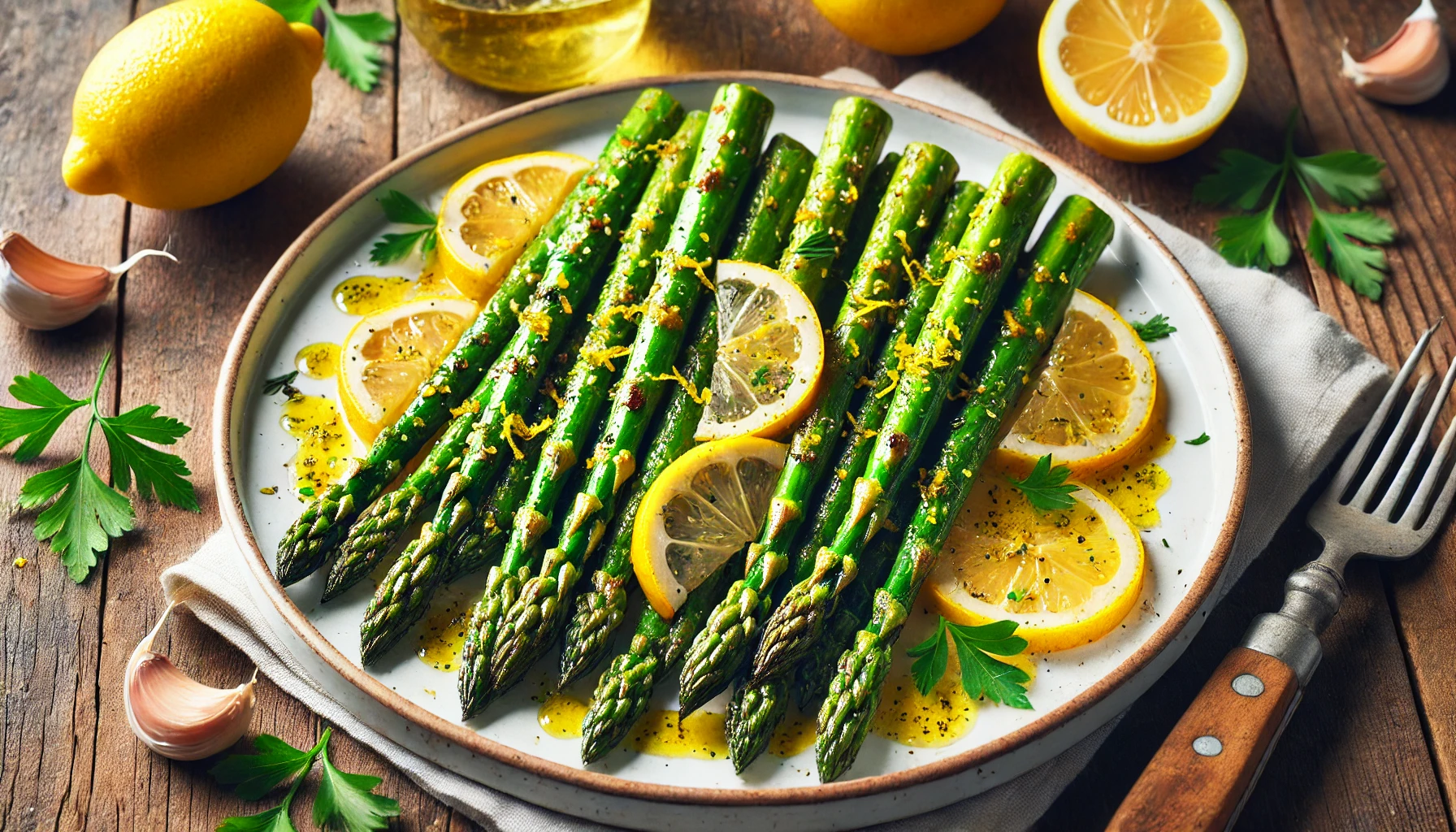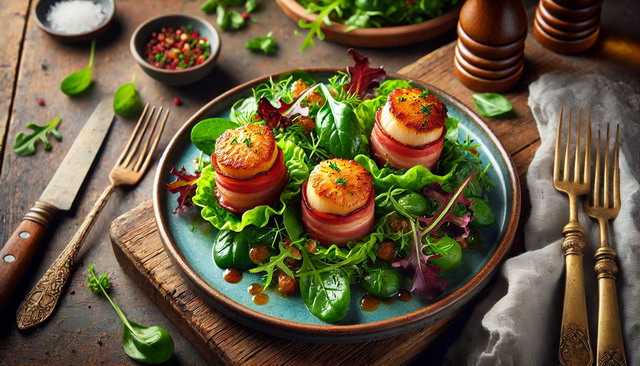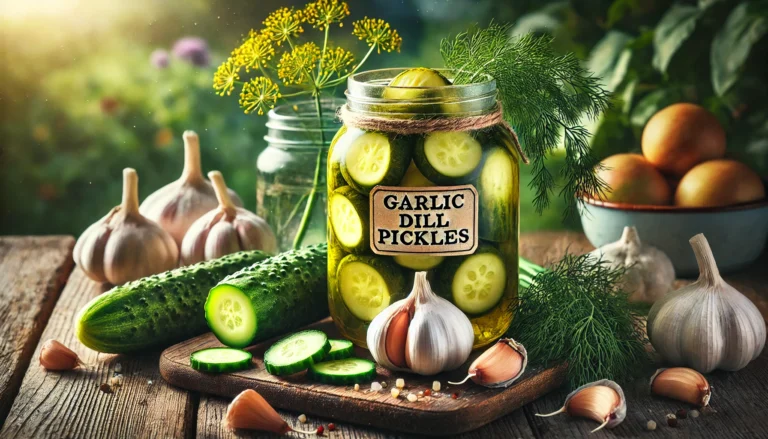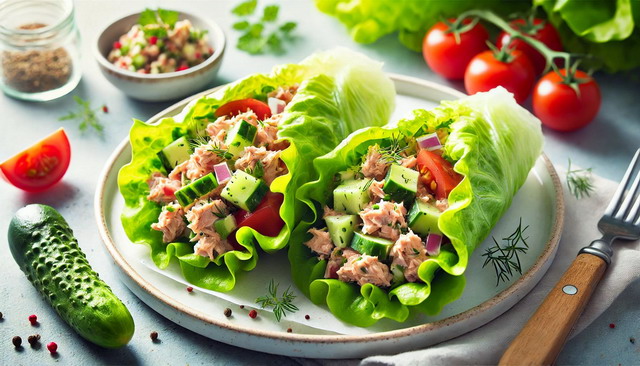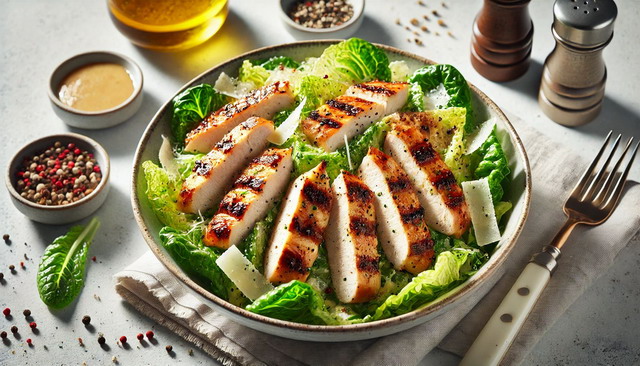Lemon Garlic Roasted Asparagus is a delightful side dish that brings vibrant flavors to any meal. This dish combines the refreshing zest of lemon with the robust taste of garlic, making it not just tasty but also a healthy addition to the plate. Preparing asparagus this way elevates its natural flavors, and the simple ingredients allow the vegetable to shine.
Originating from Mediterranean cuisines, this recipe is not only easy to make but also packs a nutritional punch. Asparagus is rich in vitamins and antioxidants, making it a popular choice for health-conscious individuals. The roasting method enhances its texture and makes it a versatile side that pairs well with various main dishes.
Exploring Lemon Garlic Roasted Asparagus opens up the possibility of incorporating more green vegetables into one’s diet. It showcases how simple preparations can yield impressive results, encouraging a shift towards healthier eating habits.
Key Takeaways
- This dish combines lemon and garlic to enhance asparagus flavor.
- Roasting asparagus boosts its nutritional value and texture.
- It serves as a versatile side that complements many meals.
Origins of Lemon Garlic Roasted Asparagus
Lemon Garlic Roasted Asparagus is a dish that combines two timeless ingredients: asparagus and garlic. Asparagus has a long history, dating back to ancient Egypt and Rome.
Garlic, known for its strong flavor and health benefits, has been used for centuries in various cultures. It is believed to have originated in Central Asia.
The combination of lemon and garlic with roasted asparagus highlights Mediterranean culinary traditions. This blend showcases a refreshing and vibrant flavor profile.
In modern cooking, roasting vegetables has gained popularity for enhancing their natural sweetness. Lemon juice adds acidity, balancing the dish while promoting the freshness of asparagus.
This dish is often featured in contemporary kitchens, especially during spring when asparagus is in season. Its simplicity and flavor make it a staple side dish for various main courses.
Lemon Garlic Roasted Asparagus reflects a growing appreciation for healthy, flavorful meals. Preparing it involves minimal ingredients, allowing the components to shine individually.
Health Benefits
Lemon Garlic Roasted Asparagus offers significant health benefits stemming from its key ingredients. The combination of asparagus, garlic, and lemon brings together essential nutrients that contribute to overall wellness.
Nutritional Profile of Asparagus
Asparagus is low in calories, making it a suitable addition to various diets. A 100-gram serving offers only 20 calories while providing essential vitamins and minerals.
- Vitamins: Rich in Vitamins A, C, E, and K.
- Folate: Crucial for DNA synthesis and repair.
- Fiber: Promotes digestive health.
Asparagus also contains antioxidants like quercetin, which can help combat oxidative stress. The potassium content supports heart health by helping to regulate blood pressure. Additionally, its protein content, around 2.2 grams per 100 grams, provides a plant-based source of this macronutrient.
Health Impacts of Garlic and Lemon
Garlic is known for its health-promoting properties, notably its ability to boost the immune system. It contains compounds like allicin, which can have antimicrobial effects.
- Heart Health: Regular consumption of garlic may lower blood pressure and improve cholesterol levels.
- Anti-inflammatory: It helps reduce inflammation in the body.
Lemon, on the other hand, is an excellent source of Vitamin C. This vitamin is vital for immune function and skin health. Lemons also contain flavonoids, which may help lower the risk of chronic diseases.
Using lemon juice can enhance iron absorption from plant sources, promoting better nutrition overall. Combined, garlic and lemon create a synergistic effect that enhances the health benefits of dishes like Lemon Garlic Roasted Asparagus.
Ingredient Selection
Selecting the right ingredients elevates the flavor and quality of Lemon Garlic Roasted Asparagus. Freshness and variety contribute significantly to the overall dish.
Choosing Fresh Asparagus
Look for asparagus spears that are vibrant green, firm, and straight. The tips should be tightly closed and not wilted. Thickness matters—thinner spears cook faster but may be less flavorful, while thicker ones have a heartier taste. Avoid any that appear limp or have a yellow hue.
When purchasing, consider seasonal availability. Asparagus is best enjoyed in spring, making it a prime candidate for freshness during that time. Shop at local farmers’ markets for peak season yields, ensuring the asparagus is just harvested. Storing fresh asparagus upright in a jar with water can extend its life, keeping it crisp until ready to use.
Types of Garlic to Use
Garlic variety impacts the dish’s flavor profile. Common types include hardneck and softneck garlic. Hardneck garlic tends to have a bolder flavor and is ideal for roasting, while softneck garlic is milder and more versatile.
For this recipe, using fresh garlic cloves ensures a robust taste. Whole cloves offer a sweet, caramelized flavor when roasted, while minced garlic provides a sharper bite. Roasting whole heads of garlic alongside the asparagus can infuse a rich essence into the dish. Choose organic garlic for optimal taste and avoid any with sprouted or blemished cloves for the best results.
Selecting the Best Lemons
Fresh lemons enhance the dish with acidity and brightness. Look for lemons that are firm, smooth, and have a vibrant yellow color. Heavy lemons indicate juiciness, which is particularly beneficial for this recipe.
Meyer lemons, a sweeter and less acidic variety, are a great option for a balanced flavor. Standard Eureka or Lisbon lemons provide a traditional tang. When preparing for the recipe, zesting the lemons adds an aromatic element while the juice delivers the needed acidity. Always wash the lemons to remove any wax before use, ensuring the healthfulness of your dish.
Preparation Techniques
Proper preparation is essential for achieving the best flavor and texture in Lemon Garlic Roasted Asparagus. Key techniques include trimming and cleaning the asparagus, creating a garlic lemon mixture, and marinating the asparagus to enhance its taste.
Trimming and Cleaning Asparagus
To prepare asparagus, begin by rinsing it under cool running water to remove any dirt or debris. After cleaning, grab a single spear and bend it gently. It will naturally snap at the point where the tender part meets the tough end. This method ensures the removal of woody stems.
For a larger batch, align the spears and trim the ends with a knife to an even length, about 1-2 inches from the bottom. This creates uniform cooking. Pat the asparagus dry with a clean kitchen towel to eliminate excess moisture, which is crucial for achieving a nice roast.
Creating the Garlic Lemon Mixture
The garlic lemon mixture elevates the asparagus with fresh flavors. Start by mincing 2-3 cloves of garlic. For a zesty profile, zest one lemon and then juice it, ensuring there are no seeds.
Combine the minced garlic, lemon zest, and lemon juice in a small bowl. Add 2-3 tablespoons of olive oil to this mix, along with salt and pepper to taste. The olive oil not only enhances flavor but also helps in roasting. It’s vital to whisk the mixture until fully combined.
Marinating the Asparagus
Marinating the asparagus enhances its flavor before roasting. In a large bowl, add the trimmed asparagus and pour the garlic lemon mixture over it. Toss the spears gently to ensure they are evenly coated.
Let the asparagus marinate for at least 15-30 minutes at room temperature. This allows the flavors to penetrate the spears. For a more intense flavor, marinating in the refrigerator for up to 2 hours is effective. Ensure that the asparagus is not submerged in liquid; a light coating is enough for flavor infusion.
Cooking Methods
Lemon garlic roasted asparagus can be prepared using various cooking methods. The two popular techniques are oven roasting and grilling, each offering distinct flavors and textures.
Oven Roasting Steps
Oven roasting is a straightforward method that enhances the natural sweetness of asparagus. Begin by preheating the oven to 425°F (220°C).
Next, wash and trim the asparagus, removing the tough ends. In a bowl, toss the asparagus with olive oil, minced garlic, lemon juice, salt, and pepper until evenly coated.
Arrange the asparagus on a baking sheet in a single layer to ensure even cooking. Roast for 12-15 minutes, depending on the thickness of the spears. Check for tenderness by piercing them with a fork. For added flavor, consider sprinkling grated Parmesan cheese in the last two minutes of roasting.
Grilling for Smoky Flavor
Grilling asparagus adds a delightful smoky flavor and char. Start by preheating the grill to medium-high heat.
As with oven roasting, wash and trim the asparagus. Toss with olive oil, minced garlic, and a squeeze of lemon juice for extra zest.
Place the asparagus directly on the grill or use a grill basket to prevent them from falling through. Cook for about 5-7 minutes, turning frequently for even grill marks. Look for a vibrant green color and slightly softened texture to indicate doneness. A sprinkle of lemon zest right before serving enhances the flavor profile.
Serving Suggestions
Lemon Garlic Roasted Asparagus pairs well with various proteins and side dishes, enhancing both flavors and presentation. Complementing this dish with suitable foods elevates the dining experience.
Pairing with Proteins
For a balanced meal, Lemon Garlic Roasted Asparagus works excellently with proteins. Grilled chicken, seasoned with herbs, complements the asparagus’ flavor perfectly.
Other great options include:
- Baked Salmon: The richness of salmon pairs nicely with the brightness of lemon.
- Pork Tenderloin: Its savory taste enhances the lightness of asparagus.
- Steak: A well-seasoned steak offers a robust contrast, making for an appealing plate.
Each of these proteins can amplify the dish’s overall profile while maintaining a light and fresh meal.
Side Dishes and Wine Pairing
This roasted asparagus dish can enrich various side dishes, promoting a satisfying meal.
- Quinoa Salad: The nutty flavor of quinoa complements the vibrancy of the asparagus.
- Garlic Mashed Potatoes: Creamy potatoes provide a hearty contrast.
- Couscous: Its light texture paired with herbs can enhance the dish’s freshness.
For wine pairing, a crisp Sauvignon Blanc is ideal. Its acidity matches well with the lemon, while a light Pinot Grigio offers a refreshing option. These wines elevate the dining experience, making every bite more enjoyable.
Storage and Reheating
Proper storage and reheating techniques are essential for preserving the flavor and texture of lemon garlic roasted asparagus. Following these methods ensures that leftovers remain delicious and safe to eat.
Storing Leftovers
To store leftover lemon garlic roasted asparagus, wait for it to cool to room temperature. This helps prevent condensation inside the storage container, which can lead to sogginess.
Place the asparagus in an airtight container. Layering the spears vertically can help minimize breakage and preserve their shape. For optimal freshness, refrigerate within two hours of cooking.
Stored properly, the asparagus can last in the refrigerator for up to 3-5 days. For longer storage, consider freezing it. Wrap the cooled asparagus tightly in plastic wrap or use a freezer-safe container. Frozen asparagus remains good for up to 3 months.
Best Practices for Reheating
Reheating lemon garlic roasted asparagus requires careful attention to maintain its quality. The ideal method is to use an oven or stovetop, as these options help retain the crispness of the asparagus.
Preheat the oven to 350°F (175°C). Place the asparagus on a baking sheet and cover it loosely with foil to prevent drying out. Heat for about 10-15 minutes.
Alternatively, for a stovetop method, heat a non-stick skillet over medium heat. Add a small amount of oil or butter and sauté the asparagus for about 5-7 minutes, stirring occasionally.
Microwaving is convenient but may lead to a softer texture. If using a microwave, place the asparagus in a microwave-safe dish with a splash of water. Heat in 30-second intervals until warmed through, checking frequently to avoid overcooking.
Frequently Asked Questions
This section addresses common inquiries regarding the preparation and cooking of lemon garlic roasted asparagus, including texture, seasoning, cooking methods, and complementary sauces.
How can I achieve a perfectly crispy texture when roasting asparagus?
To achieve a crispy texture, it is crucial to select fresh asparagus with firm stalks. Preheat the oven to a high temperature, typically around 400°F (200°C), and space the asparagus evenly on the baking sheet. Avoid overcrowding to allow for optimal roasting.
What are the best practices for seasoning asparagus with lemon and garlic?
Start by tossing the asparagus with olive oil for even coating. Add minced garlic and freshly squeezed lemon juice, ensuring thorough distribution. A sprinkle of salt and pepper enhances the flavor, while lemon zest can add an extra layer of brightness.
Can you roast asparagus with the lemon garlic mixture in an air fryer, and if so, how?
Yes, asparagus can be roasted in an air fryer. Coat the asparagus with olive oil, garlic, and lemon as usual. Place it in the air fryer basket in a single layer and cook at 400°F (200°C) for about 8-10 minutes, shaking halfway through for even cooking.
Is it necessary to blanch asparagus before combining it with lemon and garlic for roasting?
Blanching is not necessary but can enhance the color and tenderness of asparagus. If desired, blanch in boiling water for 1-2 minutes before quickly transferring to ice water. This step can be skipped if a firmer texture is preferred.
What are the steps to creating a lemon garlic butter sauce for asparagus?
To create a lemon garlic butter sauce, melt unsalted butter in a small saucepan over low heat. Add minced garlic and sauté until fragrant, taking care not to burn it. Stir in fresh lemon juice and zest, then pour the sauce over the roasted asparagus just before serving.
How do you incorporate lemon garlic flavors into a pasta dish featuring asparagus?
To incorporate lemon garlic flavors into a pasta dish, sauté minced garlic in olive oil before adding cooked pasta and blanched asparagus. Finish with lemon zest, juice, and grated Parmesan cheese for a balanced flavor.
